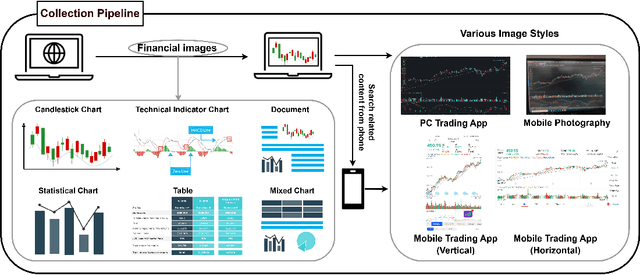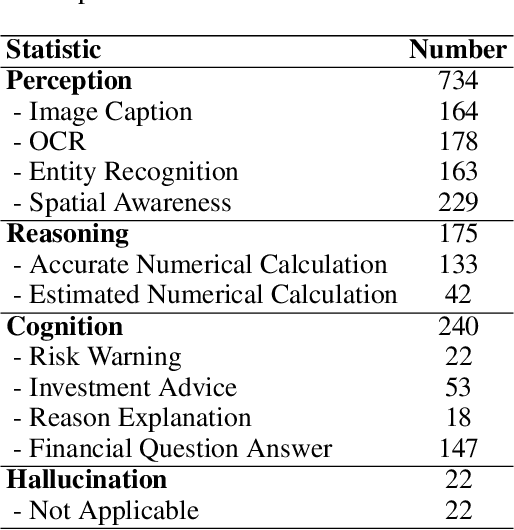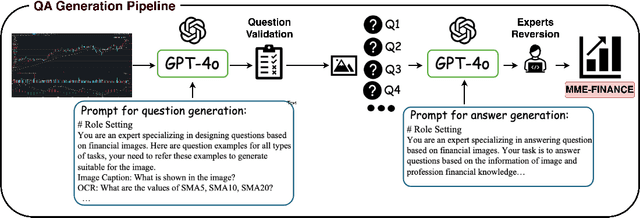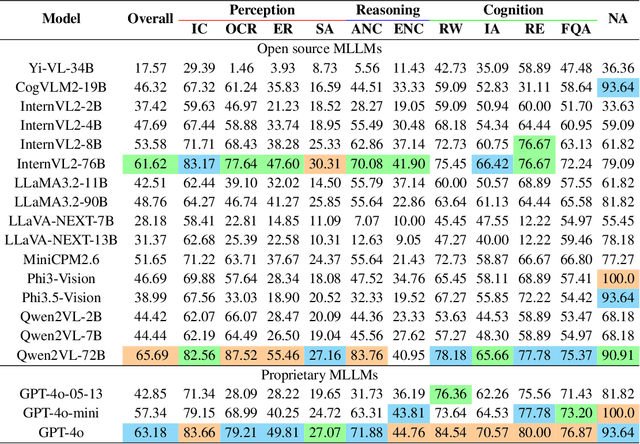Che Liu
Enhancing Abnormality Grounding for Vision Language Models with Knowledge Descriptions
Mar 05, 2025Abstract:Visual Language Models (VLMs) have demonstrated impressive capabilities in visual grounding tasks. However, their effectiveness in the medical domain, particularly for abnormality detection and localization within medical images, remains underexplored. A major challenge is the complex and abstract nature of medical terminology, which makes it difficult to directly associate pathological anomaly terms with their corresponding visual features. In this work, we introduce a novel approach to enhance VLM performance in medical abnormality detection and localization by leveraging decomposed medical knowledge. Instead of directly prompting models to recognize specific abnormalities, we focus on breaking down medical concepts into fundamental attributes and common visual patterns. This strategy promotes a stronger alignment between textual descriptions and visual features, improving both the recognition and localization of abnormalities in medical images.We evaluate our method on the 0.23B Florence-2 base model and demonstrate that it achieves comparable performance in abnormality grounding to significantly larger 7B LLaVA-based medical VLMs, despite being trained on only 1.5% of the data used for such models. Experimental results also demonstrate the effectiveness of our approach in both known and previously unseen abnormalities, suggesting its strong generalization capabilities.
SuPreME: A Supervised Pre-training Framework for Multimodal ECG Representation Learning
Feb 27, 2025Abstract:Cardiovascular diseases are a leading cause of death and disability worldwide. Electrocardiogram (ECG) recordings are critical for diagnosing and monitoring cardiac health, but obtaining large-scale annotated ECG datasets is labor-intensive and time-consuming. Recent ECG Self-Supervised Learning (eSSL) methods mitigate this by learning features without extensive labels but fail to capture fine-grained clinical semantics and require extensive task-specific fine-tuning. To address these challenges, we propose $\textbf{SuPreME}$, a $\textbf{Su}$pervised $\textbf{Pre}$-training framework for $\textbf{M}$ultimodal $\textbf{E}$CG representation learning. SuPreME applies Large Language Models (LLMs) to extract structured clinical entities from free-text ECG reports, filter out noise and irrelevant content, enhance clinical representation learning, and build a high-quality, fine-grained labeled dataset. By using text-based cardiac queries instead of traditional categorical labels, SuPreME enables zero-shot classification of unseen diseases without additional fine-tuning. We evaluate SuPreME on six downstream datasets covering 127 cardiac conditions, achieving superior zero-shot AUC performance over state-of-the-art eSSL and multimodal methods by over 1.96\%. Results demonstrate the effectiveness of SuPreME in leveraging structured, clinically relevant knowledge for high-quality ECG representations. All code and data will be released upon acceptance.
MedVLM-R1: Incentivizing Medical Reasoning Capability of Vision-Language Models (VLMs) via Reinforcement Learning
Feb 26, 2025Abstract:Reasoning is a critical frontier for advancing medical image analysis, where transparency and trustworthiness play a central role in both clinician trust and regulatory approval. Although Medical Visual Language Models (VLMs) show promise for radiological tasks, most existing VLMs merely produce final answers without revealing the underlying reasoning. To address this gap, we introduce MedVLM-R1, a medical VLM that explicitly generates natural language reasoning to enhance transparency and trustworthiness. Instead of relying on supervised fine-tuning (SFT), which often suffers from overfitting to training distributions and fails to foster genuine reasoning, MedVLM-R1 employs a reinforcement learning framework that incentivizes the model to discover human-interpretable reasoning paths without using any reasoning references. Despite limited training data (600 visual question answering samples) and model parameters (2B), MedVLM-R1 boosts accuracy from 55.11% to 78.22% across MRI, CT, and X-ray benchmarks, outperforming larger models trained on over a million samples. It also demonstrates robust domain generalization under out-of-distribution tasks. By unifying medical image analysis with explicit reasoning, MedVLM-R1 marks a pivotal step toward trustworthy and interpretable AI in clinical practice.
Knowledge-enhanced Multimodal ECG Representation Learning with Arbitrary-Lead Inputs
Feb 25, 2025Abstract:Recent advances in multimodal ECG representation learning center on aligning ECG signals with paired free-text reports. However, suboptimal alignment persists due to the complexity of medical language and the reliance on a full 12-lead setup, which is often unavailable in under-resourced settings. To tackle these issues, we propose **K-MERL**, a knowledge-enhanced multimodal ECG representation learning framework. **K-MERL** leverages large language models to extract structured knowledge from free-text reports and employs a lead-aware ECG encoder with dynamic lead masking to accommodate arbitrary lead inputs. Evaluations on six external ECG datasets show that **K-MERL** achieves state-of-the-art performance in zero-shot classification and linear probing tasks, while delivering an average **16%** AUC improvement over existing methods in partial-lead zero-shot classification.
MEDA: Dynamic KV Cache Allocation for Efficient Multimodal Long-Context Inference
Feb 24, 2025Abstract:Long-context Multimodal Large Language Models (MLLMs) that incorporate long text-image and text-video modalities, demand substantial resources as their multimodal Key-Value (KV) caches grow with increasing input lengths, challenging inference efficiency. Existing methods for KV cache compression, in both text-only and multimodal LLMs, have neglected attention density variations across layers, thus often adopting uniform or progressive reduction strategies for layer-wise cache allocation. In this work, we propose MEDA, a dynamic layer-wise KV cache allocation method for efficient multimodal long-context inference. As its core, MEDA utilizes cross-modal attention entropy to determine the KV cache size at each MLLMs layer. Given the dynamically allocated KV cache size at each layer, MEDA also employs a KV pair selection scheme to identify which KV pairs to select and a KV pair merging strategy that merges the selected and non-selected ones to preserve information from the entire context. MEDA achieves up to 72% KV cache memory reduction and 2.82 times faster decoding speed, while maintaining or enhancing performance on various multimodal tasks in long-context settings, including multi-images and long-video scenarios. Our code is released at https://github.com/AIoT-MLSys-Lab/MEDA.
BP-GPT: Auditory Neural Decoding Using fMRI-prompted LLM
Feb 21, 2025Abstract:Decoding language information from brain signals represents a vital research area within brain-computer interfaces, particularly in the context of deciphering the semantic information from the fMRI signal. Although existing work uses LLM to achieve this goal, their method does not use an end-to-end approach and avoids the LLM in the mapping of fMRI-to-text, leaving space for the exploration of the LLM in auditory decoding. In this paper, we introduce a novel method, the Brain Prompt GPT (BP-GPT). By using the brain representation that is extracted from the fMRI as a prompt, our method can utilize GPT-2 to decode fMRI signals into stimulus text. Further, we introduce the text prompt and align the fMRI prompt to it. By introducing the text prompt, our BP-GPT can extract a more robust brain prompt and promote the decoding of pre-trained LLM. We evaluate our BP-GPT on the open-source auditory semantic decoding dataset and achieve a significant improvement up to 4.61 on METEOR and 2.43 on BERTScore across all the subjects compared to the state-of-the-art method. The experimental results demonstrate that using brain representation as a prompt to further drive LLM for auditory neural decoding is feasible and effective. The code is available at https://github.com/1994cxy/BP-GPT.
Machine learning for modelling unstructured grid data in computational physics: a review
Feb 13, 2025Abstract:Unstructured grid data are essential for modelling complex geometries and dynamics in computational physics. Yet, their inherent irregularity presents significant challenges for conventional machine learning (ML) techniques. This paper provides a comprehensive review of advanced ML methodologies designed to handle unstructured grid data in high-dimensional dynamical systems. Key approaches discussed include graph neural networks, transformer models with spatial attention mechanisms, interpolation-integrated ML methods, and meshless techniques such as physics-informed neural networks. These methodologies have proven effective across diverse fields, including fluid dynamics and environmental simulations. This review is intended as a guidebook for computational scientists seeking to apply ML approaches to unstructured grid data in their domains, as well as for ML researchers looking to address challenges in computational physics. It places special focus on how ML methods can overcome the inherent limitations of traditional numerical techniques and, conversely, how insights from computational physics can inform ML development. To support benchmarking, this review also provides a summary of open-access datasets of unstructured grid data in computational physics. Finally, emerging directions such as generative models with unstructured data, reinforcement learning for mesh generation, and hybrid physics-data-driven paradigms are discussed to inspire future advancements in this evolving field.
ClinicalBench: Can LLMs Beat Traditional ML Models in Clinical Prediction?
Nov 10, 2024Abstract:Large Language Models (LLMs) hold great promise to revolutionize current clinical systems for their superior capacities on medical text processing tasks and medical licensing exams. Meanwhile, traditional ML models such as SVM and XGBoost have still been mainly adopted in clinical prediction tasks. An emerging question is Can LLMs beat traditional ML models in clinical prediction? Thus, we build a new benchmark ClinicalBench to comprehensively study the clinical predictive modeling capacities of both general-purpose and medical LLMs, and compare them with traditional ML models. ClinicalBench embraces three common clinical prediction tasks, two databases, 14 general-purpose LLMs, 8 medical LLMs, and 11 traditional ML models. Through extensive empirical investigation, we discover that both general-purpose and medical LLMs, even with different model scales, diverse prompting or fine-tuning strategies, still cannot beat traditional ML models in clinical prediction yet, shedding light on their potential deficiency in clinical reasoning and decision-making. We call for caution when practitioners adopt LLMs in clinical applications. ClinicalBench can be utilized to bridge the gap between LLMs' development for healthcare and real-world clinical practice.
MME-Finance: A Multimodal Finance Benchmark for Expert-level Understanding and Reasoning
Nov 05, 2024



Abstract:In recent years, multimodal benchmarks for general domains have guided the rapid development of multimodal models on general tasks. However, the financial field has its peculiarities. It features unique graphical images (e.g., candlestick charts, technical indicator charts) and possesses a wealth of specialized financial knowledge (e.g., futures, turnover rate). Therefore, benchmarks from general fields often fail to measure the performance of multimodal models in the financial domain, and thus cannot effectively guide the rapid development of large financial models. To promote the development of large financial multimodal models, we propose MME-Finance, an bilingual open-ended and practical usage-oriented Visual Question Answering (VQA) benchmark. The characteristics of our benchmark are finance and expertise, which include constructing charts that reflect the actual usage needs of users (e.g., computer screenshots and mobile photography), creating questions according to the preferences in financial domain inquiries, and annotating questions by experts with 10+ years of experience in the financial industry. Additionally, we have developed a custom-designed financial evaluation system in which visual information is first introduced in the multi-modal evaluation process. Extensive experimental evaluations of 19 mainstream MLLMs are conducted to test their perception, reasoning, and cognition capabilities. The results indicate that models performing well on general benchmarks cannot do well on MME-Finance; for instance, the top-performing open-source and closed-source models obtain 65.69 (Qwen2VL-72B) and 63.18 (GPT-4o), respectively. Their performance is particularly poor in categories most relevant to finance, such as candlestick charts and technical indicator charts. In addition, we propose a Chinese version, which helps compare performance of MLLMs under a Chinese context.
Can Medical Vision-Language Pre-training Succeed with Purely Synthetic Data?
Oct 17, 2024



Abstract:Medical Vision-Language Pre-training (MedVLP) has made significant progress in enabling zero-shot tasks for medical image understanding. However, training MedVLP models typically requires large-scale datasets with paired, high-quality image-text data, which are scarce in the medical domain. Recent advancements in Large Language Models (LLMs) and diffusion models have made it possible to generate large-scale synthetic image-text pairs. This raises the question: *Can MedVLP succeed using purely synthetic data?* To address this, we use off-the-shelf generative models to create synthetic radiology reports and paired Chest X-ray (CXR) images, and propose an automated pipeline to build a diverse, high-quality synthetic dataset, enabling a rigorous study that isolates model and training settings, focusing entirely from the data perspective. Our results show that MedVLP models trained *exclusively on synthetic data* outperform those trained on real data by **3.8%** in averaged AUC on zero-shot classification. Moreover, using a combination of synthetic and real data leads to a further improvement of **9.07%**. Additionally, MedVLP models trained on synthetic or mixed data consistently outperform those trained on real data in zero-shot grounding, as well as in fine-tuned classification and segmentation tasks. Our analysis suggests MedVLP trained on well-designed synthetic data can outperform models trained on real datasets, which may be limited by low-quality samples and long-tailed distributions.
 Add to Chrome
Add to Chrome Add to Firefox
Add to Firefox Add to Edge
Add to Edge